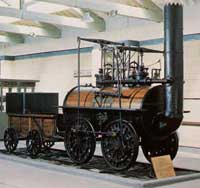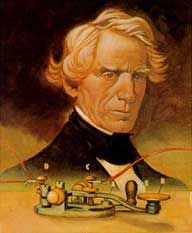 at left: Stockton & Darlington first locomotive, built 1825
at left: Stockton & Darlington first locomotive, built 1825
The 1830s witnessed the first large-scale building of railroads in the U.S. In 1830, there were less than 40 miles of rail lines; by 1840, there were over 2700 miles, and by 1850, over 8500 miles. Growth continued exponentially in the following decades.
By the way, more than three-quarters of the rail lines were north of the Mason-Dixon line; this played a major role in helping the North industrialize and later defeat the South in the Civil War.
Corresponding growth in England was from 98 miles in 1830, to 1498 miles in 1840 and 6621 miles in 1850.
Arguably just as important was the telegraph. On May 24, 1844, Samuel F. B. Morse transmitted his famous message, "What hath God wrought?" from Washington to Baltimore — instantaneously, over an electric wire. In a world where the fastest communication had been on horseback (or at best, semaphore) this was a revolution.
